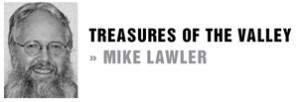The Crescenta Valley, because of its location, has been fortunate in having some of the great names in America as residents. Being near Hollywood and the entertainment industry has supplied us with a never-ending stream of famous names, and the proximity to Disney made us home to some of the greatest animators of all time. We’re bracketed by the early aerospace industry in the San Fernando Valley on the west, and on the east, ongoing space exploration and scientific discovery at JPL and Caltech, making the valley a natural home for test pilots, scientists, and professors. Our natural beauty attracted world famous artists to live here. But who knew that one of the greats in social work lived here? Today he is virtually unknown, but his name has survived on in various schools in CV for the last 70 years.
Rev. Anderson W. Clark came to La Crescenta in 1922 retiring from a lifelong career helping children. Clark was a highly educated man, possessing two doctorate degrees in divinity and economics. He was ordained a Baptist minister and formed a congregation in Nebraska. In the 1890s he found himself drawn to the court system where children were systematically victimized by cycles of abuse and neglect. These children had no one, and were physically and emotionally scarred. Andy Clark gathered them up, healed them and found them homes with other families, what we’d call foster care today. He founded the Child Saving Institute, which is still active today as a charity for abandoned children. Clark placed over 4,000 abandoned children in new homes before he retired from the Institute. Since then they’ve expanded to adoption services, care for unwed mothers, and family counseling and intervention. On their website at www.childsaving.org they state: “Child Saving Institute is committed to the tradition begun by A. W. Clark 117 years ago of ‘Responding to the cry of a child.’”
When WWI started Clark volunteered for the Red Cross, and headed the first Red Cross delegation to cross into Germany with aid for the allied prisoners. His work won him international acclaim, and service as a presidential advisor.
Now in his 70s, he was ready to rest. He settled in for retirement with his wife, son, and daughter in a tiny little house on Glenada near Holy Redeemer Church. But like most “givers” he couldn’t stop serving others, and he immediately threw himself into local charities. He was a whirlwind of activity, heading civic groups, coordinating charitable organizations, and teaming with ministers and priests of local churches. Peruse any local paper from the ‘20s and ‘30s and his name is everywhere as a head of various local service groups. He was nicknamed “The Good Angel,” and one old timer who knew him describes him as “a palpable saint.”
But his reward would be personal tragedy. In December of 1933 a grateful resident rewarded Clark and his wife with a New Year’s holiday in Palm Springs, a chance to get away from the constant rain that had been plaguing the valley. While he was gone the famous New Year’s Flood swept though the valley, destroying his house, critically injuring his son, and killing his daughter. He raced back to head the rescue efforts, and helped dig his daughter’s body out of the mud piled up against the church on Montrose Avenue across from Holy Redeemer. Bowed, but not broken, he served the valley for four more years with the same energy and selflessness he had before his family and possessions were taken from him. He helped the valley rebuild, healed families that had been torn apart, and then died quietly in April 1938.
In an outpouring of gratitude for the work he had done, the local residents renamed the local school Anderson W. Clark Junior High. Various local schools have carried his name continuously since then as a perpetual tribute to the man who made service to the community and volunteerism a local trait that survives and thrives today.

